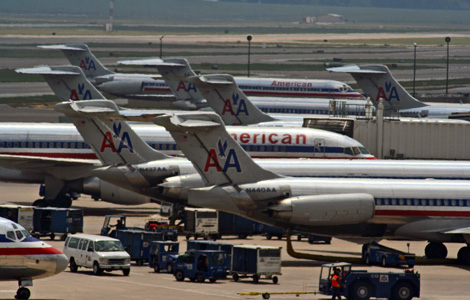The Squeeze
Aviation capacity may look like it’s growing, but really, it’s just getting sliced thinner
When a gain on one side requires a loss on the other, we call that a zero-sum game, and in aviation, that’s frequently what happens in the name of increasing capacity. Many people simply assume we’ll go faster and farther, carry more and cost less – because that’s the way it’s always been. But if you look closely at the aviation world, you find areas where capacity grows only by cramming more things of smaller size into the same space.
Most notoriously, that’s the way the game is played with airline seats. Seat “pitch” is the term the industry uses for the space between rows of seats, another way of defining legroom, albeit indirectly. It’s changing all the time, but the typical pitch in economy is now about 31 inches, down from 34 or more, with Spirit Airlines coming in at a shin-scraping 29 inches. Spirit, not so coincidentally, is the discount carrier that pioneered the idea of non-reclining seats. Meanwhile, all airlines will tell you that seat padding has gotten thinner, but hasn’t sacrificed any comfort because of modern cushioning materials, hence the closer spacing between rows.
Asian airlines tend to really cram people in, perhaps because the average person there is not as bulky as the rotund Westerners with their trendy obesity. Passengers gripe constantly about seat pitch, especially on long flights, but the only way for really large people — tall or wide — to find comfort is to buy it. If you dig deep into your wallet, and pay for business class and higher, the knee room goes up by as much as a foot. The seats not only recline, they’re wider and — again for a price — lie flat like a bed for long-distance flights.
Another area that’s feeling the squeeze is radio communications, and, in particular, the air band, which spans frequencies from 108 to 137 MHz. The radio spectrum is like real estate — they’re not making any more of it. In the beginning, voice communication radios had 70 channels spaced 200 kHz apart from 118 to 132 MHz, with the lower bands from 108 up to just below 118 dedicated to navigation channels. As voice traffic grew, they split the channels in half, with 100 kHz between them. In the 1950s, they did it again, down to 50 kHz, and then, as the industry boomed in the 1970s, to 25 kHz, providing 720 channels. Now the Europeans have taken to splitting each channel into three parts, with 8.33 kHz spacing. Some radios in the U.S. offer that option as well, mostly for use at high altitude. This splitting and re-splitting has been a boon for the people who make the radios, because they’ve had successive waves of obsolescence to drive buyers. It gets a little bit more expensive to improve the selectivity of a radio so that the receiver can accept only the frequency it’s tuned to, but channel splitting has been the only way to increase capacity in the air band since day one.
Now a lot of voice communication is expected to be replaced by digital text messages, which should eliminate errors and the problems of congestion that typify a busy push period at a major terminal when everybody is trying to talk at once. (You can hear the radio chatter during crazy hour at JFK here).
The ultimate scarce commodity in the aviation business is airspace, although the fact that it’s three-dimensional makes air traffic density a different problem from highway congestion. The choke points show up near major airports, and not so much in the en route airspace. All those arriving flights have to funnel into a runway or two, which means air traffic controllers have to work at sequencing the arrivals so they have enough space between them to allow for no-panic landings and their wakes don’t toss around the following aircraft. Very large aircraft attach the word “heavy” to their call signs as a reminder to Air Traffic Control that they require a larger trailing interval.
Until recently, human skill and experience provided the ideal interval between aircraft, but now computers and ultra-precision navigation promise to narrow that interval to, perhaps, the limits imposed by trailing wakes. In other words, airplanes will arrive in sequences and at intervals that are much closer than they are now. Will that alone eliminate delays in arrivals and departures? No. Only the construction of more runways near the busiest cities can do that. London is struggling with the problem right now, and may end up locating new runways far from downtown.
Capacity comes dear. And it’s wise to remember that when we gain something, something else usually has to give.
